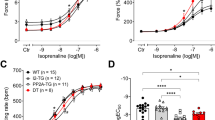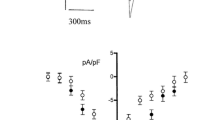Abstract
Exposure of neonatal rat cardiomyocytes for 3 days to the muscarinic cholinoceptor agonist carbachol led to a concentration-dependent increase in adenylyl cyclase stimulation by the \-adrenoceptor agonist isoproterenol by up to 115% (at 1 mmol/l carbachol). In addition, direct adenylyl cyclase stimulation by forskolin was increased in carbachol (1 mmol/l)-treated cells by 32010. Pretreatment of the rat cardiomyocytes with pertussis toxin, which enhances adenylyl cyclase activity by a functional inactivation of the inhibitory G-protein (Gi), was performed to investigate the possible role of Gi proteins in carbachol-induced sensitization of adenylyl cyclase stimulation. After pretreatment of the cells with pertussis toxin, the carbachol-mediated increase in forskolin-stimulated adenylyl cyclase activity was lost and the carbachol-mediated increase in \-adrenoceptor-stimulated adenylyl cyclase activity was attenuated. Labelling of the 40 kDa pertussis toxin substrates in cardiomyocyte membranes was decreased by carbachol in a concentration-dependent manner by up to 34010 (at 1 mmol/l carbachol). The number and affinity of \1-adrenoceptors was unaltered following the chronic carbachol treatment.
The specific protein synthesis inhibitor Pseudomonas exotoxin A was used to study whether the carbachol-induced decrease in the level of pertussis toxin-sensitive G-proteins and increase in adenylyl cyclase activity depend on de-novo protein synthesis. Pseudomonas exotoxin A inhibits peptide chain elongation by ADP-ribosylating elongation factor 2. Treatment of the cells with 1 ng/ml Pseudomonas exotoxin A for 3 days led to a reduction in the subsequent ADP-ribosylation of elongation factor 2 in the cytosol of the heart muscle cells by 57%. Exposure of the cells to 1 mmol/l carbachol for 3 days increased ADP-ribosylation of elongation factor 2 by 40% concomitant with a slight (about 20%) increase in the total protein content of the cardiomyocytes. The partial protein synthesis inhibition by Pseudomonas exotoxin A had no influence on the carbachol-induced decrease in the level of pertussis toxin-sensitive G-proteins. Similarly, the carbachol-induced increase in adenylyl cyclase responsiveness also remained unaltered by Pseudomonas exotoxin A.
The data presented indicate that chronic muscarinic cholinoceptor agonist treatment decreases the level of α-subunits of Gi- proteins. This decrease in Giα- subunits is apparently at least in part responsible for the observed increase in adenylyl cyclase responsiveness after chronic carbachol treatment.
Similar content being viewed by others
References
Attali B, Vogel Z (1989) Long-term opiate exposure leads to reduction of the αi-1 subunit of GTP-binding proteins. J Neurochem 53:1636–1639
Böhm M, Gierschik P, Jakobs KH, Pieske B, Schnabel P, Ungerer M, Erdmann E (1990) Increase of Giα in human hearts with dilated but not ischemic cardiomyopathy. Circulation 82:1249–1265
Bristow MR, Minobe W, Rasmussen R, Larrabee P, Skerl L, Klein JW, Anderson FL, Murray J, Mestroni L, Karwande SV, Fowler M, Ginsburg R (1992) \-Adrenergic neuroeffector abnormalities in the failing human heart are produced by local rather than systemic mechanisms. J Clin Invest 89:803–815
Brown JH, Buxton IL, Brunton LL (1985) α1-Adrenergic and muscarinic cholinergic stimulation of phosphoinositide hydrolysis in adult rat cardiomyocytes. Circ Res 57:532–537
Brown JH, Martinson EA (1993) Phosphoinositide-generated second messengers in cardiac signal transduction. Trends Cardiovasc Med 2:209–214
Denniss AR, Marsh JD, Quigg RJ, Gordon JB, Colucci WS (1989) \-Adrenergic receptor number and adenylate cyclase function in denervated transplanted and cardiomyopathic human hearts. Circulation 79:1028–1034
Eschenhagen T (1993) G proteins and the heart. Cell Biol Int 17:723–749
Feldman AM (1993) Modulation of adrenergic receptors and G-transduction proteins in failing human ventricular myocardium. Circulation [Suppl IV]:27–34
Gallo MP, Alloatti G, Eva C, Oberto A, Levi RC (1993) M1 muscarinic receptors increase calcium current and phosphoinositide turnover in guinea-pig ventricular cardiocytes. J Physiol 471:41–60
Galper JB, Dziekan LC, O'Hara DS, Smith TW (1982) The biphasic response of muscarinic cholinergic receptors in cultured heart cells to agonists: Effects on receptor number and affinity in intact cells and homogenates. J Biol Chem 257:10344–10356
Gierschik P, Sidiropoulos D, Spiegel A, Jakobs KH (1987) Purification and immunochemical characterization of the major pertussis-toxin-sensitive guanine-nucleotide binding protein of bovine neutrophil membranes. Eur J Biochem 165:185–194
Green A (1987) Adenosine receptor down-regulation and insulin resistance following prolonged incubation of adipocytes with an A1-adenosine receptor agonist. J Biol Chem 262:15702–15707
Green A, Johnson JL, Milligan G (1990) Down-regulation of Gi sub-types by prolonged incubation of adipocytes with an A1 adenosine receptor agonist. J Biol Chem 265:5206–5210
Hershberger RE, Feldman AM, Anderson FL, Kimball JA, Wynn JR, Bristow MR (1991) Mr 40000 and Mr 39000 pertussis toxin substrates are increased in surgically denervated dog ventricular myocardium. J Cardiovasc Pharmacol 17:568–575
Horn EM, Danilo P, Apfelbaum MA, Barr ML, Pepino P, Powers ER, Smith CR, Rose EA, Bilezikian JP (1991) Beta-adrenergic receptor sensitivity and guanine nucleotide regulatory proteins in transplanted human hearts and autotransplanted baboons. Transplantation 52:960–966
Hodges TD, Bailey JC, Fleming JW, Kovacs RJ (1989) Selective parasympathectomy increases the quantity of inhibitory guanine nucleotide-binding proteins in canine cardiac ventricle. Mol Pharmacol 36:72–77
Jakobs KH, Saur W, Schultz G (1976) Reduction of adenylate cyclase activity in lysates of human platelets by the α-adrenergic component of epinephrine. J Cyclic Nucleotide Res 2:381–392
Jakobs KH, Aktories K, Schultz G (1979) GTP-dependent inhibition of cardiac adenylate cyclase by muscarinic cholinergic agonists. Naunyn-Schmiedeberg's Arch Pharmacol 310:113–119
Laemmli UK (1970) Cleavage of structural proteins during the assembly of the head of bacteriophage T4. Nature 227:680–685
Löffelholz K, Pappano AJ (1985) The parasympathetic neuroeffector junction of the heart. Pharmacol Rev 37:1–24
Lowry OH, Rosebrough NJ, Farr AL, Randall RJ (1951) Protein measurement with the Folin reagent. J Biol Chem 193:265–275
Longabaugh JP, Didsbury J, Spiegel A, Stiles G (1989) Modification of the rat adipocyte A1 adenosine receptor-adenylate cyclase system during chronic exposure to an A1 adenosine receptor agonist: alterations in the quantity of Gsα and Giα are not associated with changes in their mRNAs. Mol Pharmacol 36:681–688
Mende U, Eschenhagen T, Geertz B, Schmitz W, Scholz H, Schulte am Esch J, Sempell R, Steinfath M (1992) Isoprenaline-induced increase in the 40/41 kDa pertussis toxin substrates and functional consequences on contractile response in the rat heart. Naunyn-Schmiedeberg's Arch Pharmacol 345:44–50
Milligan G, Green A (1991) Agonist control of G-protein levels. Trends Pharmacol Sci 12:207–209
Parsons WJ, Stiles G (1987) Heterologous desensitization of the inhibitory A1 adenosine receptor-adenylate cyclase system in rat adipocytes. J Biol Chem 262:841–847
Reithmann C, Gierschik P, Mueller U, Werdan K, Jakobs KH (1990) Pseudomonas exotoxin A prevents \-adrenoceptor-induced upregulation of Gi protein α-subunits and adenylyl cyclase desensitization in rat heart muscle cells. Mol Pharmacol 37:631–638
Reithmann C, Gierschik P, Sidiropoulos D, Werdan K, Jakobs KH (1989a) Mechanism of noradrenaline-induced heterologous desensitization of adenylate cyclase stimulation in rat heart muscle cells: increase in the level of inhibitory G-protein α-subunits. Eur J Pharmacol 172:211–221
Reithmann C, Gierschik P, Werdan K, Jakobs KH (1991) Role of inhibitory G protein α-subunits in adenylyl cyclase desensitization. Mol Cell Endocrinol 82:C215-C221
Reithmann C, Wieland F, Jakobs KH, Werdan K (1989b) Intrinsic sympathomimetic activity of \-adrenoceptor antagonists: down-regulation of cardiac \1- and \2-adrenoceptors. Eur J Pharmacol 170:243–255
Scatchard G (1949) The attraction of protein for small molecules and ions. Ann NY Acad Sci 51:660–672
Werdan K, Erdmann E (1989) Preparation and culture of embryonic and neonatal heart muscle cells: modification of transport activity. Methods Enzymol 173:634–662
Author information
Authors and Affiliations
Rights and permissions
About this article
Cite this article
Reithmann, C., Werdan, K. Chronic muscarinic cholinoceptor stimulation increases adenylyl cyclase responsiveness in rat cardiomyocytes by a decrease in the level of inhibitory G-protein α-subunits. Naunyn-Schmiedeberg's Arch Pharmacol 351, 27–34 (1995). https://doi.org/10.1007/BF00169060
Received:
Accepted:
Issue Date:
DOI: https://doi.org/10.1007/BF00169060




